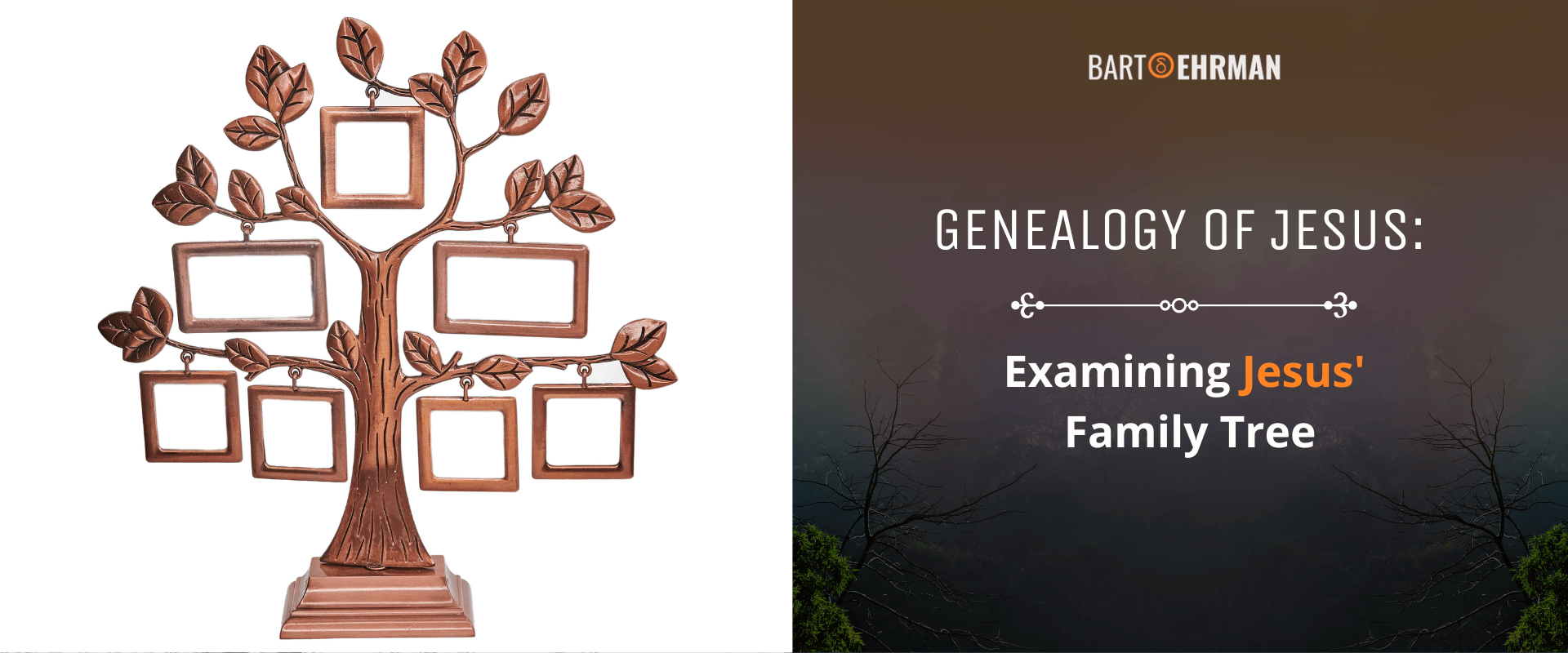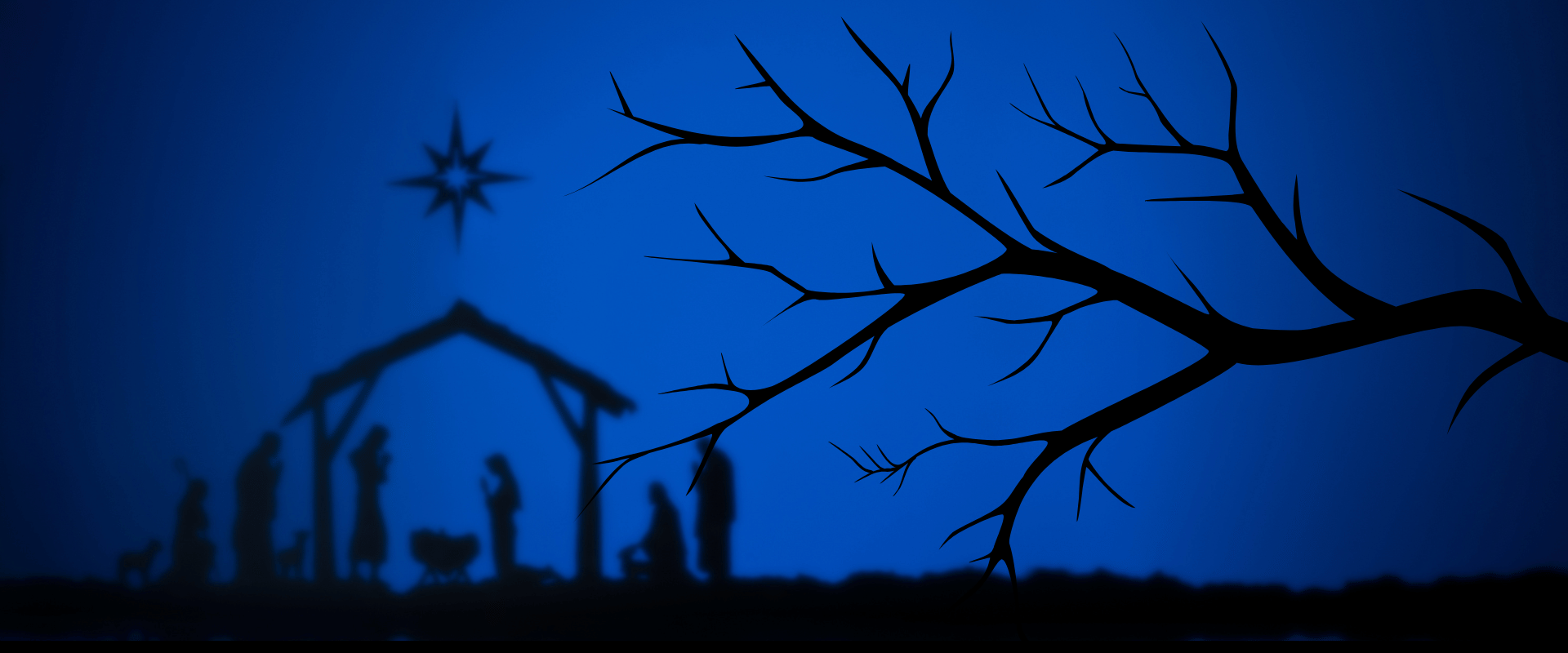Examining Jesus' Family Tree (CHART)

Written by Marko Marina, Ph.D.
Author | Historian
Author | Historian | BE Contributor
Verified! See our guidelines
Verified! See our editorial guidelines
Date written: February 7th, 2025
Disclaimer: The views and opinions expressed in this article belong to the author and do not necessarily match my own. - Dr. Bart D. Ehrman
Have you ever traced your family tree, looking for information on your ancestors? Most people in the contemporary world haven’t! For many, these issues carry little to no importance in their everyday lives. But in the ancient world, genealogies were more than just a record of ancestors — they were a vital way to establish identity, status, and legitimacy.
Family trees told stories, connected individuals to their cultural and religious heritage, and reinforced their place in society.
This brings us to Jesus' family tree, as depicted in the New Testament. Two of the Gospels (Matthew and Luke) provide detailed accounts of Jesus’ family tree. But these genealogies are far from identical which raises fascinating questions about their purpose and meaning.
Why are there two different genealogies? What do they reveal about how the Gospel authors viewed Jesus’ identity and mission? To answer these questions, we must try to set our minds in the world of antiquity where genealogies had an important function.
In his Commentary on Luke’s Gospel, Joel B. Green explains:
(Affiliate Disclaimer: We may earn commissions on products you purchase through this page at no additional cost to you. Thank you for supporting our site!)
In lineage-or descent-based status systems like that into which Jesus was born, genealogies served the crucial function of determining membership in a given kinship group. Genealogies serve as indicators of (inherited) status; as such, it is commonly recognized that they might be subject to ‘genealogical amnesia’ (where insignificant or problematic ancestors are suppressed) and idealism (where lists are adjusted to fulfill new social requirements). As a literary form, genealogies are concerned as much with theological and apologetic issues as with historical; in them resides remarkable social power.
In this article, we’ll, therefore, dive into what the Gospels have to say about the genealogy of Jesus. We’ll explore these ancient texts side by side, looking not only at their similarities and differences but also at the theological intentions behind them.
Additionally, we’ll give a bit of space to the scholarly exegesis of Jesus’ family tree, considering how historians and biblical scholars have interpreted these intriguing accounts over the centuries. Let’s uncover what these genealogies can teach us about the man at the center of Christianity.
However, before we begin, I want to invite you to check out Bart D. Ehrman’s exceptional course The Genius of Mark: Jesus the Secret Messiah. In 8 online lectures, Dr. Ehrman provides a fresh and scholarly look at the oldest Gospel, revealing nuances and delineating between history, myth, and tradition!

Jesus' family tree: Comparing Matthew’s and Luke’s Genealogies
The best way to begin our exploration of Jesus’ genealogy is to present both Matthew’s and Luke’s versions side by side. This will allow us to see their similarities and differences, as well as the unique ways each Gospel author crafted their account of Jesus’ lineage.
Matthew’s Genealogy (Matthew 1:1-17) | Luke’s Genealogy (Luke 3:23-38) |
|---|---|
1 This is the genealogy of Jesus the Messiah the son of David, the son of Abraham: | 23 Now Jesus himself was about thirty years old when he began his ministry. He was the son, so it was thought, of Joseph, |
2 Abraham was the father of Isaac, Isaac the father of Jacob, Jacob the father of Judah and his brothers, | the son of Heli, |
3 Judah the father of Perez and Zerah, whose mother was Tamar, Perez the father of Hezron, Hezron the father of Ram, | 24 the son of Matthat, the son of Levi, the son of Melki, the son of Jannai, the son of Joseph, |
4 Ram the father of Amminadab, Amminadab the father of Nahshon, Nahshon the father of Salmon, | 25 the son of Mattathias, the son of Amos, the son of Nahum, the son of Esli, the son of Naggai, |
5 Salmon the father of Boaz, whose mother was Rahab, Boaz the father of Obed, whose mother was Ruth, Obed the father of Jesse, | 26 the son of Maath, the son of Mattathias, the son of Semein, the son of Josek, the son of Joda, |
6 and Jesse the father of King David. David was the father of Solomon, whose mother had been Uriah’s wife, | 27 the son of Joanan, the son of Rhesa, the son of Zerubbabel, the son of Shealtiel, the son of Neri, |
7 Solomon the father of Rehoboam, Rehoboam the father of Abijah, Abijah the father of Asa, | 28 the son of Melki, the son of Addi, the son of Cosam, the son of Elmadam, the son of Er, |
8 Asa the father of Jehoshaphat, Jehoshaphat the father of Jehoram, Jehoram the father of Uzziah, | 29 the son of Joshua, the son of Eliezer, the son of Jorim, the son of Matthat, the son of Levi, |
9 Uzziah the father of Jotham, Jotham the father of Ahaz, Ahaz the father of Hezekiah, | 30 the son of Simeon, the son of Judah, the son of Joseph, the son of Jonam, the son of Eliakim, |
10 Hezekiah the father of Manasseh, Manasseh the father of Amon, Amon the father of Josiah, | 31 the son of Melea, the son of Menna, the son of Mattatha, the son of Nathan, the son of David, |
11 and Josiah the father of Jeconiah and his brothers at the time of the exile to Babylon. | 32 the son of Jesse, the son of Obed, the son of Boaz, the son of Salmon, the son of Nahshon, |
12 After the exile to Babylon: Jeconiah was the father of Shealtiel, Shealtiel the father of Zerubbabel, | 33 the son of Amminadab, the son of Ram, the son of Hezron, the son of Perez, the son of Judah, |
13 Zerubbabel the father of Abihud, Abihud the father of Eliakim, Eliakim the father of Azor, | 34 The son of Jacob, the son of Isaac, the son of Abraham, the son of Terah, the son of Nahor, |
14 Azor the father of Zadok, Zadok the father of Akim, Akim the father of Elihud, | 35 the son of Serug, the son of Reu, the son of Peleg, the son of Eber, the son of Shelah, |
15 Elihud the father of Eleazar, Eleazar the father of Matthan, Matthan the father of Jacob, | 36 the son of Cainan, the son of Arphaxad, the son of Shem, the son of Noah, the son of Lamech, |
16 and Jacob the father of Joseph, the husband of Mary, and Mary was the mother of Jesus who is called the Messiah. | 37 the son of Methuselah, the son of Enoch, the son of Jared, the son of Mahalalel, the son of Kenan, |
17 Thus there were fourteen generations in all from Abraham to David, fourteen from David to the exile to Babylon, and fourteen from the exile to the Messiah. | 38 the son of Enosh, the son of Seth, the son of Adam, the son of God. |
Wow! That’s quite something. A long list of names and generations in both versions of the genealogy of Jesus. Now, let’s take a closer look at each version to explore their unique details and significance.
FREE COURSE!
WHY I AM NOT A CHRISTIAN
Raw, honest, and enlightening. Bart's story of why he deconverted from the Christian faith.
Over 6,000 enrolled!
The Genealogy of Jesus in Matthew: Jesus’ Lineage to Abraham
In contrast to Mark’s Gospel, which begins with Jesus’ baptism, Matthew opens with a genealogy of Jesus that traces his line of descent. The very first verse of Matthew sets the tone for the entire Gospel: “This is the genealogy of Jesus the Messiah, the son of David, the son of Abraham.”
This introduction highlights the dual focus of the genealogy: Jesus as the fulfillment of the promises to Abraham, the father of the Jewish people, and as the descendant of King David, the great ruler of Israel whose lineage was expected to produce the Messiah.
As Raymond E. Brown notes in his masterpiece The Birth of the Messiah: “The name ‘Jesus Christ’ binds the title ‘Messiah’ indivisibly to Jesus and serves as a good preparation for a genealogy and a narrative both of which will stress that Jesus is the fulfillment of Jewish messianic hopes.”
Furthermore, Matthew’s genealogy of Jesus is carefully structured into three sets of 14 generations which represent significant epochs in salvation history: From Abraham to David, from David to the Babylonian exile, and from the exile to Jesus.
This arrangement reflects Matthew’s theological intent and literary expertise. Matthew, or the individual traditionally identified as the author, was an educated figure immersed in Jewish religious tradition. Mark A. Powell, in his book Introducing the New Testament, offers an insightful explanation of Matthew’s use of the number 14:
When he relates the genealogy of Jesus he arranges the names so that they fall into three sets of fourteen generations: there were fourteen generations from Abraham to David, fourteen from David to the exile, and fourteen from the exile to Jesus. Three fourteens! Many modern readers might respond, ‘So what?’ But Matthew thinks that Jesus is the Messiah, and the Messiah is the son of David, and the name ‘David’ can be written with Hebrew letters (dwd) that also serve as numerals, and those numerals are 4, 6, 4, and 4 + 6 + 4 = 14!
Another striking feature of Matthew’s version of the genealogy of Jesus is the inclusion of four women: Tamar, Rahab, Ruth, and Bathsheba, alongside Mary.
Their presence is highly unusual in ancient genealogies, which traditionally focused on male lineage. Each of these women’s stories involves elements of irregular or socially scandalous circumstances, yet they play pivotal roles in advancing God’s salvific plan.
As Brown highlights, their inclusion serves a profound theological purpose. These women foreshadow Mary’s extraordinary role in Jesus’ birth, where divine intervention overcame societal norms and expectations.
Through its careful structure, symbolic use of numbers, and the inclusion of women with unconventional backgrounds, Matthew’s genealogy of Jesus serves, first and foremost, as a profound theological statement. In other words, it can’t be taken as an objective (historical) presentation of Jesus’ family tree — a notion that Origen fully acknowledged in the 3rd century.
With this foundation in place, we now turn to Luke’s Gospel to explore how he presents Jesus’ lineage. Let’s take a look!
The Genealogy of Jesus in Luke: From Adam to Jesus
At the outset, it must be noted that Jesus' family tree in Luke is markedly different from the one presented in Matthew. As Joseph A. Fitzmyer explains in his Commentary on Luke:
Matthew's genealogy is openly 'messianic,' highlighting the relation to Israel and its famous forebears, David and Abraham, whereas Luke's genealogy is that of Jesus, the Son of God, with David and Abraham, mentioned only as ordinary ancestors in a line going back to the first of human beings, Adam.
Any attempt to reconcile these genealogies is, in my view, a futile exercise rooted in ignoring a fundamental reality of the New Testament: the existence of differences, and at times outright contradictions, between the Gospels. Instead of harmonizing, it’s far more fruitful to examine what Luke’s genealogy of Jesus seeks to convey about Jesus’ identity and mission.
Is Jesus a Descendant of David?
Unlike Matthew, who begins with Abraham and highlights Jesus' connection to Israel, Luke’s genealogy reaches as far back as Adam, the progenitor of the human race. This broader scope underscores Luke’s theological emphasis on Jesus’ relationship to all humanity. For Luke, as Bart D. Ehrman explains in his book The New Testament: A Historical Introduction, more than any other Gospel author we’ve seen, Jesus’ salvation comes to the entire world.
By tracing Jesus’ lineage to Adam, Luke expands the focus from Jesus’ Jewish heritage to his universal significance, presenting him as the savior of all people, not just those of Israel.
This raises the question: Is Jesus a descendant of David? Theologically, the answer is rooted in the Jewish belief that the Messiah must descend from David’s line. Historically, however, we lack any verifiable evidence to confirm this claim.
As far as we can tell, the historical Jesus came from a modest, lower-class family in Nazareth, with no way to establish a direct link to King David, who lived nearly 1,000 years earlier.
The association with David likely emerged as a theological reflection after Jesus’ death, when his followers, convinced of his resurrection and messianic identity, constructed a narrative to “prove” his Davidic lineage.
It’s possible that Jesus himself alluded to this connection during his ministry, but this remains speculative. What is clear is that the idea of Jesus as a descendant of David served an essential role in early Christian theology, affirming his identity as the long-awaited Messiah.

How Many Generations from Adam to Jesus?
Luke’s genealogy of Jesus stands out not only for its scope but also for its length. Unlike Matthew’s meticulously structured genealogy of three sets of 14 generations, Luke lists 77 generations. This number, often associated with completeness and divine perfection in ancient traditions, carries theological weight.
Fitzmyer explains the use of groupings of seven names as a mnemonic device “because oral tradition undoubtedly played a great role in the composition of such lists.” The use of seven, a number symbolizing wholeness, adds a layer of significance to the genealogy’s structure and reinforces its portrayal of Jesus as the culmination of divine purpose.
Moreover, the inclusion of 77 generations emphasizes the universality of Luke’s narrative. By extending the genealogy to Adam, Luke connects Jesus not only to Israel’s history but also to the origins of humanity itself.
Finally, Luke’s inclusion of lesser-known or unique names in his genealogy suggests that he either relied on alternative sources or crafted the genealogy to align with his theological aims. This brings us to a crucial question: What is the theological meaning of the genealogy of Jesus in Luke?
Perhaps Michael Wolter, in his Commentary on Luke, offers the clearest answer:
The intention of the form of genealogies – especially rising ones – lies in construing identity, in which the creation of identity proceeds above all from the endpoint. In the present case, this would be God in his role as the creator of Adam... The line that the genealogy draws from Jesus to God does not wish to specify Jesus’s genealogical origin. Instead, it wants to name the level on which Jesus’s divine sonship has its significance. The concern is with God’s relation to all humanity. Jesus does not become a new Adam through this, but Luke uses Adam’s divine sonship as a model in order to mark out the framework of meaning for understanding Jesus’s divine sonship.
Despite their differences, both genealogies of Jesus have one thing in common: They are, first and foremost, a theological declaration! Luke, through the genealogy of Jesus, ties his identity to the broader human story and emphasizes God’s redemptive plan for all people.
Conclusion
After writing this piece, I might, contrary to most people today, take a closer look at my family tree! Genealogies, as this exploration reveals, were far more significant in the ancient world, serving not only as records of ancestry but as powerful tools for establishing identity, status, and legitimacy.
The genealogy of Jesus both in Matthew and Luke is no exception, though these versions differ markedly in structure, scope, and theological intent.
Matthew’s genealogy presents Jesus as the fulfillment of Jewish messianic hopes, emphasizing his Davidic and Abrahamic lineage through three sets of 14 generations. This carefully structured account integrates symbolic numbers and includes notable women to highlight God’s salvific plan.
In contrast, Luke’s genealogy extends back to Adam, underscoring Jesus’ connection to all humanity and portraying his mission as universal. By listing 77 generations, a number tied to completeness, Luke reflects the divine purpose behind salvation history.
Both genealogies, as theological declarations, reveal how the Gospel authors used these lineage accounts to frame Jesus’ identity within God’s redemptive plan for the world.
FREE COURSE!
WHY I AM NOT A CHRISTIAN
Raw, honest, and enlightening. Bart's story of why he deconverted from the Christian faith.
Over 6,000 enrolled!
